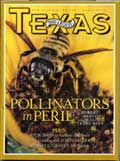
At Issue
From the pen of Robert L. Cook
Few topics generate more questions to our agency than high fences. These seven-to-eight-foot-high fences are often referred to as deer-proof fences.
Landowners interested in managing wildlife usually build high fences with the goal of producing greater numbers of mature, large-antlered bucks. This goal cannot be achieved if hunters on adjacent land kill bucks that wander onto their property before they reach maturity at 51/2 to 71/2 years of age. The high fence keeps bucks on the managed property so that they can be harvested only when they are mature and larger antlered.
High fences help landowners manage their habitat. Wildlife managers know that much of Texas has too many deer. To produce large-antlered, healthy, well-fed deer, their habitat and preferred forage must be abundant and kept in good condition year-round. This cannot be achieved if the deer on adjacent lands are underharvested and overpopulated. Unless such deer are fenced out, they simply crowd onto the managed land immediately after the hunting season. High fences are built to keep the overpopulation of deer off the land where habitat improvement and better deer quality is desired.
The opposition to high fences often comes from landowners who feel fenced out when their neighbor constructs a high fence along their shared property line. Because the deer from the neighbor’s land can no longer freely jump the regular livestock fence and come onto their property, the adjacent landowners can harvest fewer deer, especially fewer bucks. In addition, some folks believe that deer inside high fences have become privatized, or privately owned by the landowner, as opposed to being property of the people of Texas. This is simply not the case under Texas law.
When Texas Parks and Wildlife staff are asked about these issues, we respond that private landowners in Texas have the legal right to build any kind of fence around their property of whatever height that they want, as long as it does not pose a hazard to people and does not block the flow of water, light or air to other land. As a general rule,there is no minimum or maximum acreage that may be fenced. Moreover, no state agency, including the Texas Parks and Wildlife Department, has the authority to regulate the type or height of fences on private land, nor are landowners liable for the restriction of the movement of wild animals by the fences they erect.
The trespass laws of Texas clearly state that anyone who enters or hunts on private land must have the permission of the landowner. Wild animals are the property of the people of this state. Private landowners have the legal right to control access to their land and the activities that take place on their land. I firmly believe in support and respect the trespass laws of Texas, as do most Texans.
Finally, there is no evidence that high fences are more detrimental to deer or to other wildlife than are other fences. In fact, there is solid evidence that with good habitat management and strict harvest criteria, that the genetics of white-tailed deer can be improved, and plant diversity increased, inside high-fenced property.

